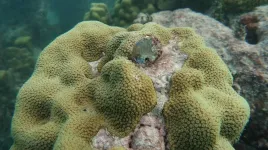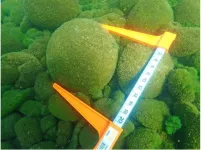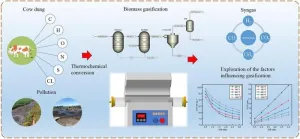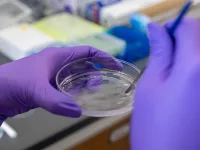(Press-News.org) Researchers say mapping the genetic code of the brushtail possum will benefit those working to both conserve and control the animal.
In a five-year long study, just published in Nature Communications, an international group of researchers led by the University of Otago, has assembled the entire genetic code of the marsupial mammal.
The work also uncovered where and when their genes are expressed, and revealed surprising details about their population diversity, reproduction, and origins.
Study lead Associate Professor Tim Hore, of Otago’s Department of Anatomy, describes possums as “a fascinating animal that is loved in one country and a cause of concern in another”.
“They are hunted in Aotearoa New Zealand for their fur, and controlled for conservation, but treasured and protected in Australia. Having their full genetic code is important for both countries as efforts to manage their respective populations are being held back by the lack of this knowledge,” he says.
“In New Zealand, where the possum is a harmful introduced species, we can use the information to help guide control and eradication strategies, by tracking and monitoring target populations on the basis of their genes; but in the same way our work will also be useful for its conservation in Australia, where it is a valued native species.”
A potential novel way to improve possum population management has also been revealed by the DNA sequencing, based on chemical communication genes the researchers have discovered.
“Possums are nocturnal, so non-visual means of communication are really important. We uncovered possum genes responsible for carrying scent in urine, and found that although they are silenced in newborns, they are switched on in adults, particularly males. Molecules produced from these genes could be used to lure possums towards a trap or keep them away from pest-free areas,” he says.
Professor Dan Tompkins, Science Director at the study co-funder Predator Free 2050 Limited, was excited about the results for the research and development pathways they open up.
“Through the Predator Free 2050 mission we are driving to eradicate possums – along with rats and stoats – from the whole of Aotearoa to protect native biodiversity, and we are always on the lookout for more targeted, efficient and humane ways of getting the job done,” Professor Tompkins says.
“Deciphering their genetic code provides us with an invaluable new knowledge base that underpins and enables exploration of a range of better approaches to do just that, from possum-species toxins to fertility control, and the exciting new ideas leveraging scent communication proposed here.”
Researchers also uncovered new details regarding the establishment of possums in New Zealand from Australian populations.
Introduced in the late 19th century to establish a fur trade, possums went on to become serious pests, damaging many forest ecosystems and killing native birds and some insects.
As carriers of bovine tuberculosis, they also threaten biosecurity and trade. The New Zealand government alone spends more than $150 million per year controlling possum numbers.
In comparison, they are a cultural and ecological treasure in their native range, where Southern Aboriginal tribes use their skins for cloaks, depicting images and stories on them throughout life.
Study co-first author Dr Donna Bond, also of Otago’s Department of Anatomy, says possums from the study were collected from Otago Peninsula and other sites near Dunedin, but were genetic hybrids tracing back to discrete populations in Tasmania and the Australian mainland.
“Although the possums introduced in the 19th century were low in numbers, perhaps a few hundred, because they are mixed up from at least four different Australian populations, the New Zealand animals we tested had more genetic diversity than those from Australia,” she says.
END
Critical step made for managing brushtail possums
2023-10-17
ELSE PRESS RELEASES FROM THIS DATE:
Surprising discovery about coral’s resilience could help reefs survive climate change
2023-10-17
The factors affecting coral’s resilience — its ability to adapt to and survive environmental changes — seem to be more nuanced than scientists believed.
In a study published Oct. 18 in the journal Global Change Biology, researchers reveal surprising findings about a species common to Caribbean waters. The discovery may help improve efforts to save corals from bleaching and other consequences of climate change.
A team led by Assistant Professor of Biological Sciences Carly Kenkel at the USC Dornsife College of Letters, Arts and ...
Ushering in the era of light-powered 'multi-level memories'
2023-10-17
We live in an era of data deluge. The data centers that are operated to store and process this flood of data use a lot of electricity, which has been called a major contributor to environmental pollution. To overcome this situation, polygonal computing systems with lower power consumption and higher computation speed are being researched, but they are not able to handle the huge demand for data processing because they operate with electrical signals, just like conventional binary computing systems.
The Korea Institute of Science ...
Staggering increase in opioid-related deaths among people experiencing homelessness, new study finds
2023-10-17
London, ON, October 17, 2023 – People experiencing homelessness accounted for an increasing proportion of fatal opioid-related deaths in Ontario, Canada, reaching one in six such deaths by 2021, according to new research from ICES, Western University and Lawson Health Research Institute.
In one of the first reports to track the continuous increase in opioid-related mortality in the province among people experiencing homelessness, researchers found that the quarterly proportion of opioid-related overdose ...
Subalpine forests in the Northern Rockies are fire resilient—for now
2023-10-17
Over 4,800 years in the Northern Rockies during wet periods and dry periods, subalpine forests consistently recovered from wildfires, growing back vegetation and leaving evidence of their resilience in lake sediment cores.
Kyra Clark-Wolf, now a CU Boulder postdoc with the North Central Climate Adaptation Center (NC CASC), led the study as part of her dissertation research. NC CASC is a partnership of CU Boulder and the United States Geological Survey.
“I thought we might see different ecosystem responses to past fires between wet and dry periods,” said Clark-Wolf. “But ...
Unique marimo threatened by rising lake temperatures
2023-10-17
Rising lake water temperatures threaten the survival of marimo, unique algal balls found only in cold lakes. Kobe University researchers clarified that the warmer it gets, the more the inward decomposition outpaces the outward growth of these life forms, making them increasingly fragile.
Moss balls, or “marimo” in Japanese, are popular pet water plants that are not a moss but a special growth form of filamentous algae. They are found naturally in lakes in northern Japan and cold lakes of ...
How to scientifically, efficiently, and cost-effectively treat the wastewater generated from anaerobic digestion?
2023-10-17
The resource utilization of waste is an important means to implement the construction of ecological civilization. Agricultural waste contains rich renewable resources and has high potential value in fertilization and energy conversion. Anaerobic digestion technology is a promising technology for treating agricultural waste. Anaerobic digestion refers to the digestion technology in which organic matter is decomposed into CH4, CO2, H2O and H2S by facultative bacteria and anaerobic bacteria under anaerobic conditions, which can transform solid organic matter into soluble organic matter. Not only does it have the advantages of stable process and low operation cost, the biogas produced can also ...
Novel hydrogel finds new aptamers, or ‘chemical antibodies,’ in days
2023-10-17
UNIVERSITY PARK, Pa. — One double-helix strand of DNA could extend six feet, but it is so tightly coiled that it packs an entire sequence of nucleotides into the tiny nucleus of a cell. If that same DNA was instead split into two strands and divided into many, many short pieces, it would become trillions of uniquely folded 3D molecular structures, capable of bonding to and possibly manipulating specifically shaped molecules — if they’re the perfect fit.
These short, single-stranded segments of DNA or RNA are called aptamers, also known as “chemical antibodies.” According to Penn State researchers, ...
Virtual reality helps people with hoarding disorder practice decluttering
2023-10-17
Many people who dream of an organized, uncluttered home à la Marie Kondo find it hard to decide what to keep and what to let go. But for those with hoarding disorder — a mental condition estimated to affect 2.5% of the U.S. population — the reluctance to let go can reach dangerous and debilitating levels.
Now, a pilot study by Stanford Medicine researchers suggests that a virtual reality therapy that allows those with hoarding disorder to rehearse relinquishing possessions in a simulation of their own home could help them declutter ...
Fluctuating blood pressure: a warning sign for dementia and heart disease
2023-10-17
A new study by Australian researchers has shown that fluctuating blood pressure can increase the risk of dementia and vascular problems in older people.
Short blood pressure (BP) fluctuations within 24 hours as well as over several days or weeks are linked with impaired cognition, say University of South Australia (UniSA) researchers who led the study.
Higher systolic BP variations (the top number that measures the pressure in arteries when a heart beats) are also linked with stiffening of the arteries, associated with heart disease.
The findings have been published in the journal Cerebral Circulation – Cognition and ...
Significant gaps in UK public awareness of tell-tale cancer signs in kids and teens
2023-10-17
There are significant gaps in the UK public’s awareness of the tell-tale signs and symptoms of cancer in children and teens, with just a third of adults expressing confidence in being able to recognise them, find the results of a nationally representative survey published online in the journal Archives of Disease in Childhood.
Public awareness of the cancer signs and symptoms in this age group is much lower than it is in adults, suggesting the need for initiatives to plug this knowledge gap, say the researchers.
Childhood cancer is the leading cause of ...




